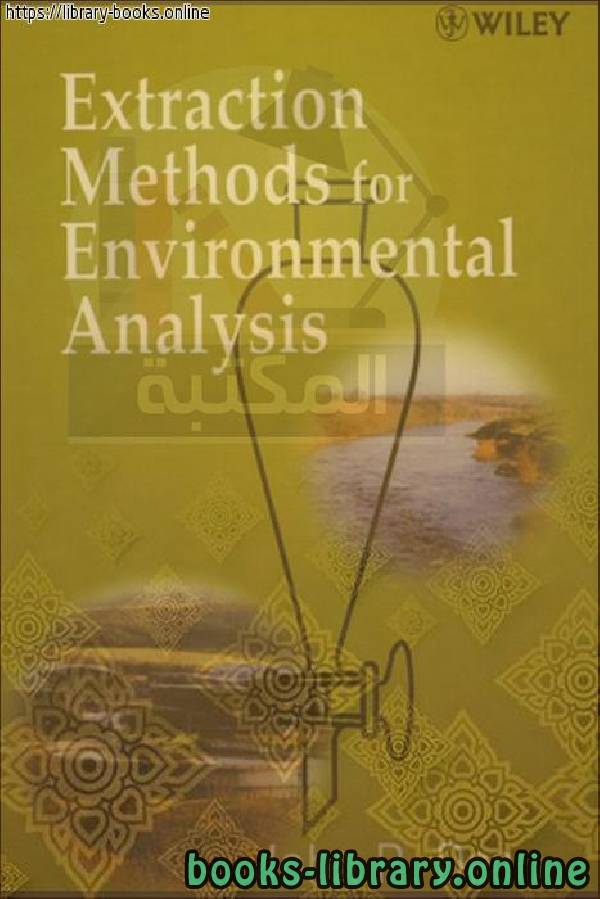📘 ❞ Extraction Methods for Environmental Analysis ❝ كتاب ــ JOHN R. DEAN اصدار 1998
Biology Books - 📖 كتاب ❞ Extraction Methods for Environmental Analysis ❝ ــ JOHN R. DEAN 📖
█ _ JOHN R DEAN 1998 حصريا كتاب ❞ Extraction Methods for Environmental Analysis ❝ 2025 Analysis: بذه عن الكتاب: Two common approaches are possible In the first approach extraction is carried out discontinuously where equilibrium established between two immiscible phases, or second approach, continuous extraction case of latter, may not be reached The selectivity and efficiency of the process critically governed by choice solvents Using aqueous organic (e g dichloromethane, chloroform, ethylene acetate, toluene, etc ) solvent pairs of solvents, more hydrophobic analytes prefer while hydrophilic compounds aqueous phase desirable quite often reflected in nature of target analyte For example if method separation to used reversed high performance liquid chromatography (HPLC), then best isolated aqueous phase this situation can injected directly into HPLC system (Note: The target well require preconcentration, e solid (see Chapter 4), achieve the appropriate level sensitivity contrast, analysed gas chromatography it addition, isolation in the allows evaporation employed Section 3 1 3) thus allowing concentration The influenced several factors that include adjustment pH prevent ionisation acids bases, formation ion with ionisable analytes, of hydrophobic complexes metal ions, adding neutral salts reduce the solubility (salting out) Biology Books مجاناً PDF اونلاين Biologically Biology a natural science concerned study life, its various forms function, how these organisms interact each other surrounding environment word biology Greek made up words: bio (βίος) meaning life And loggia ( λογία) means Biology: similarity vegetation animal cover on edges African American states, existence same fossil Branches biology Biology an ancient thousands years old modern began nineteenth century This has multiple branches Among them are: Anatomy Botany Biochemia Biogeography Biofisia Cytology cell science Ecology environmental science Development Embryology embryology Genetics genetics Histology histology Anthropology anthropology Microbiology bacteriology Molecular Biology Physiology functions organs Taxonemia taxonomy Virology virology Zoology zoology

بذه عن الكتاب:
Two common approaches are possible. In the first approach the extraction is carried out discontinuously
where equilibrium is established between two immiscible phases, or the second approach, continuous
extraction. In the case of the latter, equilibrium may not be reached. The selectivity and efficiency of
the extraction process is critically governed by the choice of the two immiscible solvents. Using
aqueous and organic (e.g. dichloromethane, chloroform, ethylene acetate, toluene, etc.) solvent pairs of
solvents, the more hydrophobic analytes prefer the organic solvent while the more hydrophilic
compounds prefer the aqueous phase. The more desirable approach is quite often reflected in the nature
of the target analyte. For example if the method of separation to be used is reversed-phase high
performance liquid chromatography (HPLC), then the target analyte is best isolated in the aqueous
phase. In this situation the target analyte can then be injected directly into the HPLC system. (Note: The
target analyte may well require preconcentration, e.g. solid phase extraction (see Chapter 4), to achieve
the appropriate level of sensitivity.) In contrast, if the target analyte is to be analysed by gas
chromatography it is best isolated in the organic solvent. In addition, isolation of the target analyte in
the organic phase allows solvent evaporation to be employed (see Section 3.1.3) thus allowing
concentration of the target analyte.
The equilibrium process can be influenced by several factors that include adjustment of pH to prevent
ionisation of acids or bases, by formation of ion-pairs with ionisable analytes, by formation of
hydrophobic complexes with metal ions, or by adding neutral salts to the aqueous phase to reduce the
solubility of the analyte (salting out).
#90
0 مشاهدة هذا اليوم#34K
1 مشاهدة هذا الشهر#71K
4K إجمالي المشاهدات- 🎁 كن أول كاتب اقتباس في هذه الصفحة واحصل على هديّة 15 من النقاط فوراً 🎁

